Tagging style in the Vegetable section: Comprehensive Vs. Concise
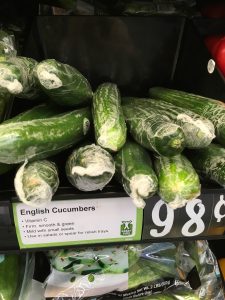
Price tag in Walmart. The description is wordy as if the store needs to educate their customers and persuade them to buy fresh vegetables. The font for the price is larger than that in Whole Foods as if the customers care more about how much money they will spend. Note that the “Great for You” icon is at the lower right corner.
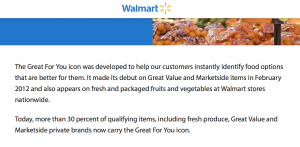
Walmart’s explanation for the “Great for you” icon. Source:http://corporate.walmart.com/global-responsibility/hunger-nutrition/great-for-you
Walmart’s tag features a comprehensive provision of information, ensuring that their customers know everything about the vegetables. The “Great for You” Icon, according to Walmart, was developed to “help our customers instantly identify food options that are better for them.” That is to say, Walmart presumes that its consumers lack familiarity with healthy veggie diets. Its shoppers need help to develop better diets and need to be persuaded that buying fresh vegetables is justifiable.

Whole Foods simply stated the growing method (organic) and the country of origin. There is no need to emphasize the price or to describe the vegetables.
Whole Foods approaches its customers with concise information even though the white space can be filled with more description. This implies the store’s belief that its customers are well informed of the values of vegetables. The inequality between the two stores is therefore evident that consumers in Walmart might be lower in socioeconomic status and consume a less healthier diet, while Wholes Foods has richer, more educated and healthier customers.
Pastry: Breaking the rules Vs. Sticking to the norms

Cute cupcakes embellished with animal figures resemble artworks. Note that this time Whole Foods stated detailed nutrition facts on the tags.

Packaged cakes placed in the open pastry corner. No enhanced interactions between customers and workers.
The unpacked cupcakes standing behind the closed-off glass window not only offers an appealing view to lingering window-shoppers but also allows workers to present to the customers how food can be prepared in an artistic manner. In this sense, they are not just selling food but also selling their “works”. And consumers are paying not just for food but also their appreciation of “works”. Walmart, however, packaged all the cakes and placed them in an open section, waiting for consumers to take the products by themselves. In this case, workers are just workers who are in charge of stocking, and consumers are just consumers who select, grab and go. They are merely completing a transaction.
Interestingly, now it is the Whole Foods shoppers that need to be convinced to buy sugary foods. This might be because they are more aware of their fitness and consider sugary products unhealthy. Walmart shoppers in contrast do not need persuasion, presumably because products rich of sugar have already become their standard diet.
Advertising campaign: Real Vs. Nominal
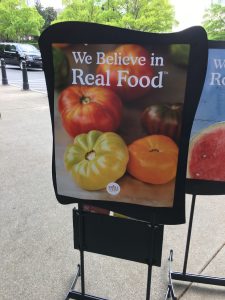
Real variables measure wealth in output. (for instance, hourly wage measured in numbers of chocolate bars). Real output does not change no matter how price fluctuates, thus it lasts longer.

Nominal variables measure wealth in money (hourly wage measured in American dollars). Price increases when money increases, so real wealth does not change but the value of money remains constant only for a short period.
The advertising campaign at the entrance of Whole Foods measures living in real variable (output of labor), emphasizing the quality of food. Walmart deems nominal variable (money) as a metric of living, directly relating spending little money to living better. This reflects the marketing values and ideologies of the two stores: Whole Foods focuses on the essential and long-term factor, while Walmart attends to the superficial and short-term factor. The materiality within the two stores reflects their ideologies. Walmart’s hanger looks “cheap”: it is only a fraction of the banner (i.e. the left part of the banner appears to be cropped off) and was tacked onto the wall. In contrast, Whole Foods framed its advertisement nicely and placed it in front of the entrance.
Coffee: Collectivism Vs. Individuality
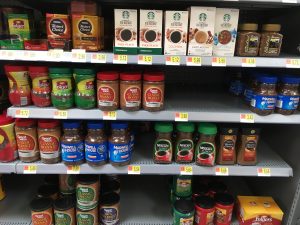
Starbucks, Nescafe, Folgere… All of them are famous brands.
Walmart maneuvers brand effect, placing the types of coffee that cater to the vast majority of customers on its shelves. In this case, shoppers follow (even if not voluntarily) the choice of others. They are deprived of their individuality, so to speak.
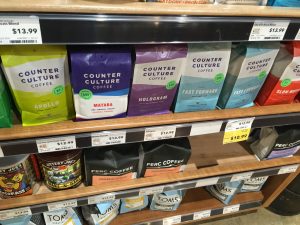
Couter-culture, Perc, Tom… Coffee brands in Whole Foods are lesser known and are more diversified.
Coffee brands in Whole Foods appear more diversified and specialized. Lesser known brands such as “Counter-culture Coffee” and “Perc Coffee” create a sense of distinctiveness which distinguished shoppers from the vast majority. Consumers are thus invited to express their individuality.
Grab and Go Section: Honest Vs. Disguised

American pizzas provided in Walmart.
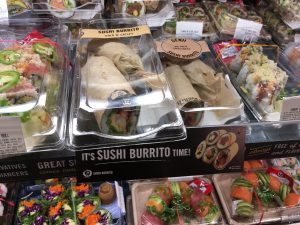
Americanized sushi burritos and sushi rolls.
Despite the numerous distinctions exhibited from the two stores, they both embody a national identity. Walmart elaborates upon this identity by selling American fast-food. Whole Foods, instead, disguises its allegiance to this identity behind a cultural veil, indirectly showing its true favor by selling Americanized cultural foods such as Americanized sushi rolls and sushi burritos. Both situate themselves only on the national scale, yet the former honestly announces this fact and the latter purposefully conceals the truth in order to gratify counter-culture customers who prefer a blend of rich cultures in their lives, in a way which approaches cultural appropriation.
Last but not the least, I recognized a similarity between “packaged food” and “packaged identity”. People quickly grab packaged food and eat without considering too much about what was inside the package. This is identical to many of us who embody our national identities and exaggerate them without thinking too much at a deeper level.